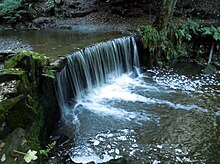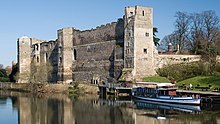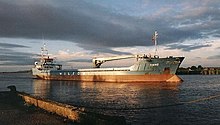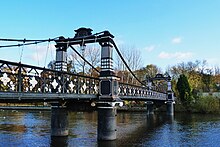User:Jokulhlaup/draftarticle2
Start[edit]
Article text[edit]
Article text structure
Lead Paragraph[edit]
Course[edit]
convert[edit]
35 to 70 inches (890 to 1,780 mm)
map[edit]
Wilden Ferry and Medieval Bridges[edit]
The crossing point and hamlet was originally known as Wilden Ferry and was latterly located upstream of the existing bridge. An earlier point for the ferry was also used and although the exact site is unknown, it was thought to be in the reach of the river between the bridge and Derwent Mouth.[1]
In 1310 the ferry replaced the last of a series of medieval bridges that crossed the Trent within this reach. Archaeological investigations in the Hemington Fields quarry, revealed that three wooden bridges were destroyed by floods between 1140 and 1309. During this period the unstable gravel bed of the Trent was affected by a succession of large floods which meant that the river shifted its course significantly during this time, demolishing the bridges and a Norman Mill weir as well.[2]
Wilden Ferry was mentioned in many of the early Acts of Parliament regarding navigation both on the River Trent and the Trent & Mersey Canal. The Wilden crossing point was used in these Acts, as Shardlow only later grew into an inland port and village on the Derbyshire side of the river.[3]
18th Century Cavendish Bridge[edit]
| Tolls taken at the bridge by virtue of an Act of Parliament being the same that were taken ay the Ferry[4] | ||
|---|---|---|
| S | d | |
| Soldiers (favour'd) | 0 | 0 |
| Foot Passengers each | 0 | 1 |
| Cows or Horned Cattle per score | 0 | ½ |
| Sheep or Lamb per score | 0 | 4 |
| Hogs and Swine per score | 0 | 6 |
| Horse, Mule or Ass not drawing |
0 | 1 |
| Cart, Wain etc with 2 wheels |
1 | 0 |
| Waggon, Wain etc with 4 wheels |
1 | 6 |
| Chaise, Chair with 2 wheels |
1 | 0 |
| Coach, Chariot, Landau etc with 4 wheels |
2 | 6 |
The delays and inconvenience of using the ferry on what had become a busy turnpike route, led to calls for changes to be made, and the first meeting to discuss the bridge was held at the nearby Old Crown Inn in 1758.[5]
The five arch masonry bridge that was subsequently built was designed by James Paine, using sandstone transported down river from the quarry at Weston-on-Trent. It was opened in 1760 and took its name from the patron of the scheme, William Cavendish, 4th Duke of Devonshire.[5] The toll for crossing the bridge was the same as that for the ferry, and these were collected until 1888 when the turnpike trusts were wound up. The crossing remained in use until the major flood of March 1947, when one of the piers was washed away and the centre of the bridge collapsed into the river.[6][4]
Modern Bridge[edit]
Following the loss of the bridge, the Army installed a temporary Bailey Bridge using the existing foundations, which continued in use until 1957, when the current concrete span was erected on a new alignment to the east of the original London Road.[5]
The toll house which survived the collapse of the bridge, was subsequently removed when the remains of the old crossing was demolished in 1960, although the slate plaque inscribed with the toll charges was retained and relocated on the approach to the new bridge.[6]
NWL[5]
- ^ "A brief history of Shardlow". Shardlow Heritage Centre. Retrieved 10 May 2013.
- ^ Brown, Anthony (2008). "Late Holocene channel changes of the Middle Trent: channel response to a thousand-year flood record". sciencedirect.com. Retrieved 10 May 2013.
- ^ The Statutes at Large: Volume 14. 1786. pp. 339–340.
- ^ a b "Toll charges stone for the Old Cavendish Bridge over the River Trent, Shardlow". picturethepast.org.uk. Retrieved 19 June 2013.
- ^ a b c d "Cavendish Bridge Conservation Area Appraisal and Study" (PDF). North West Leicestershire council. Retrieved 10 August 2013.
- ^ a b Stone, Richard (2005). River Trent. Phillimore. pp. 74–75. ISBN 1860773567.
The bridge however was washed away by flood waters in A Bailey Bridge was used as a temporary crossing until the current bridge was opened in 1957. Presently, traffic lights only allow vehicular traffic over the bridge in one direction at one particular time.
There is a hamlet named after the bridge on the Leicestershire side of the river, within the Castle Donington parish. On the Derbyshire side is the village of Shardlow.
Steam Packets[edit]
The first steam powered boats were introduced onto the Trent in 1814 by the Gainsborough Steam Packet Company, which operated a regular steam packet service using paddle steamers from Hull to Gainsborough. The Calendonia making her maiden passage in October of that year, at a speed of 14 miles per hour.[2] [3] The service was daily (except Sundays), and the packet would call at a number of ferry stathers or landing stages between the two towns. It was said that without stopping the trip could be done in less than three hours, but generally the 56 mile trip with stops would take four to five hours, meaning that passengers could travel to Hull, and return on the same day.[4][5]
In 1823 the steam packets Albion and British Queen operated this service, each on alternate days, calling at various locations including Burton and Flixborough Stather, Keadby, Butterwick Ferry and Stockwith. Both vessels having been built in the shipyards of Gainsborough.[6] The greater use of railways at the start of the 20th century meant that passenger numbers decreased until only a market day trip remained; this reduced service, using the steam packet Celia, finally ceased during the First World War.[6]
Trent - Commercial Waterway[edit]
Between Trent Falls and Keadby, coastal vessels that have navigated through the Humber still deliver cargoes at the wharves of Grove, Neap House, Gunness and Flixborough. Restrictions on size mean that the largest vessels that can be accommodated are 100m long and 4,500 tonnes. [7][8]
The need for the use of a pilot on the Trent is not compulsory for commercial craft, but is suggested for those without any experience of the river. There have been a number of incidents with ships running aground and in one case, even striking Keadby Bridge. The most recent occurence involved the Celtic Endeavour being aground near Gunness for ten days, finally being lifted off by a high tide. [9] [10][11]
strikethrough
| “ | book ref round | ” |
- Simon Winchester, The Map That Changed the World: William Smith and the Birth of Modern Geology, (2001), New York: HarperCollins, ISBN 0-14-028039-1
- Cooper, B. (1991) Transformation of a Valley: The Derbyshire Derwent, Cromford: Scarthin (originally by London: Heinemann, 1983), ISBN 0-907758-17-7
Bishop
[13]
http://www.dambusters.org.uk/after-the-dams/raids/saumur/
Stone [16]
- Barber, Charles (1993). The English Language: a historical introduction. Cambridge University Press. ISBN 978-0-521-78570-9.
Barber, J (1834). History of the County of Lincoln: From the Earliest Period to the Present Time, Volume 2. Retrieved May 11 2013. {{cite book}}: Check date values in: |accessdate= (help)
- Bishop, Patrick (2012). Target Tirpitz. HarperPress. ISBN 978-0-00-731924-4.
refs---------------------
- ^ Knight, David; Viner, Blaise (2007). "Making Archaeology Matter:Quarrying and Archaeology in the Trent Valley" (PDF). yorkarchaeology.co.uk. Retrieved 10 June 2013.
- ^ Barber, J (1834). History of the County of Lincoln: From the Earliest Period to the Present Time, Volume 2.
- ^ "Transport on the River Trent". humberpacketboats.co.uk. Retrieved 10 May 2013.
- ^ "Steam-packet-history-heritage-society". thisislincolnshire.co.uk. Retrieved 10 May 2013.
- ^ Baines 1823, pp. 16.
- ^ a b "Packet Boats and Paddle Steamers". humberpacketboats.co.uk. Retrieved 10 May 2013.
- ^ NGIA (2006). Prostar Sailing Directions 2006 North Sea Enroute. ProStar Publications. p. 53. ISBN 9781577857549.
- ^ "ports-and-wharves-of-North-Lincolnshire". northlincs.gov.uk. Retrieved 11 July 2013.
- ^ "MAIB Search Results Mithril". maib.gov.uk. Retrieved 11 July 2013.
- ^ "MAIB Search Results Maria". maib.gov.uk. Retrieved 11 July 2013.
- ^ "Freighter-Celtic-Endeavor-aground-and-refloated". news.odin.tc. Retrieved 11 July 2013.
- ^ Everard Leaver Guilford (1912). "Memorials of old Nottinghamshire" (Memorials of old Nottinghamshire. ed.). London: G. Allen. Retrieved 11 May 2013.
- ^ Bishop 2012, pp. 328
- ^ "Saumur Railway Tunnel". The Dambusters. dambusters.org.uk. Retrieved 25 October 2013.
- ^ Saumur Railway Tunnel dambusters.org.uk quoting AIR27/2128
- ^ Stone 2005, p. 14, 15
Tributaries[edit]
Although Spenser endowed the 'The beauteous Trent' with 'thirty different streams'[a] the river is joined by more than twice that number of different tributaries,[2] of which the largest in terms of flow is the Tame which drains most of the West Midlands, including Birmingham and the Black Country. The second and third largest are the Derwent and the Dove respectively; together these two rivers drain the majority of Derbyshire and Staffordshire, including the upland areas of the Peak District.[3]
The Soar which drains the majority of the county of Leicestershire, could also be considered as the second largest tributary, as it has a larger catchment area than the Dove or Derwent, but its discharge is significantly less than the Derwent, and lower than the Dove.[3]
In terms of rainfall the Derwent receives the highest annual average rainfall, whereas the Devon, which has the lowest average rainfall is the driest catchment of those tabulated.[3]
| Statistics of the Trent’s largest tributaries | ||||||||||||
|---|---|---|---|---|---|---|---|---|---|---|---|---|
| Name | County [b] | Length | Catchment Area | Discharge | Rainfall [c] | Max. Altitude | Refs | |||||
| km | mi | km2 | mi2 | m3/s | cfs | mm | in | m | ft | |||
| Blithe | 47 | 29 | 167 | 64 | 1.16 | 41 | 782 | 30.8 | 281 | 922 | [d][3][2] | |
| Devon | 47 | 29 | 377 | 146 | 1.57 | 55 | 591 | 23.3 | 170 | 560 | [e][3][2] | |
| Derwent | 118 | 73 | 1,204 | 465 | 18.58 | 656 | 982 | 38.7 | 634 | 2,080 | [f][3][2] | |
| Dove | 96 | 60 | 1,020 | 390 | 13.91 | 491 | 935 | 36.8 | 546 | 1,791 | [g][3][2] | |
| Erewash | 46 | 29 | 194 | 75 | 1.87 | 66 | 708 | 27.9 | 194 | 636 | [h][3][2] | |
| Greet | 18 | 11 | 66 | 25 | 0.30 | 11 | 655 | 25.8 | 153 | 502 | [i][3][2] | |
| Idle | 55 | 34 | 896 | 346 | 2.35 | 83 | 650 | 26 | 205 | 673 | [j][3][2] | |
| Leen | 39 | 24 | 124 | 48 | 0.67 | 24 | 686 | 27.0 | 185 | 607 | [k][3][2] | |
| Soar | 95 | 59 | 1,386 | 535 | 11.73 | 414 | 641 | 25.2 | 272 | 892 | [l][3][2] | |
| Sow | 38 | 24 | 601 | 232 | 6.33 | 224 | 714 | 28.1 | 234 | 768 | [m][3][2] | |
| Tame | 95 | 59 | 1,500 | 580 | 27.84 | 983 | 691 | 27.2 | 291 | 955 | [n][3][2] | |
| Torne | 44 | 27 | 361 | 139 | 0.89 | 31 | 615 | 24.2 | 145 | 476 | [o][3][2] | |
List of Tributaries[edit]
Tributaries of the Trent
| ||||||||||||||||||||||||||||||||||||||||||||||||||||||||||||||||||||||||||||||||||||||||||||||||||||||||||||||||||||||||||||||||||||||||||||||||||||||||||||||||||||||||||||||||||||||||||||||||||||||||||||||||||||||||||||||||||||||||||||||||||||||||||||||||||||||||||||||||||||||||
|---|---|---|---|---|---|---|---|---|---|---|---|---|---|---|---|---|---|---|---|---|---|---|---|---|---|---|---|---|---|---|---|---|---|---|---|---|---|---|---|---|---|---|---|---|---|---|---|---|---|---|---|---|---|---|---|---|---|---|---|---|---|---|---|---|---|---|---|---|---|---|---|---|---|---|---|---|---|---|---|---|---|---|---|---|---|---|---|---|---|---|---|---|---|---|---|---|---|---|---|---|---|---|---|---|---|---|---|---|---|---|---|---|---|---|---|---|---|---|---|---|---|---|---|---|---|---|---|---|---|---|---|---|---|---|---|---|---|---|---|---|---|---|---|---|---|---|---|---|---|---|---|---|---|---|---|---|---|---|---|---|---|---|---|---|---|---|---|---|---|---|---|---|---|---|---|---|---|---|---|---|---|---|---|---|---|---|---|---|---|---|---|---|---|---|---|---|---|---|---|---|---|---|---|---|---|---|---|---|---|---|---|---|---|---|---|---|---|---|---|---|---|---|---|---|---|---|---|---|---|---|---|---|---|---|---|---|---|---|---|---|---|---|---|---|---|---|---|---|---|---|---|---|---|---|---|---|---|---|---|---|---|---|---|---|---|---|---|---|---|---|---|---|---|---|---|---|---|---|---|---|
|
|
Old Stuff - old table[edit]
| Discharge of Trent at various locations | ||||||||||
|---|---|---|---|---|---|---|---|---|---|---|
| Station | County | Discharge (average) |
Discharge (maximum) |
Catchment Area |
||||||
| m3/s | cfs | m3/s | cfs | km2 | mi2 | |||||
| Stoke on Trent | 0.6 | 21 | 1.16 | 41 | 53 | 20 | [3][2] | |||
| Great Haywood | 4.4 | 160 | 97.9 | 3,460 | 325 | 125 | [3][2] | |||
| Yoxall | 12.8 | 450 | 18.58 | 656 | 1,229 | 475 | [3][2] | |||
| Drakelow | 36.1 | 1,270 | 18.58 | 656 | 3,072 | 1,186 | [3][2] | |||
| Shardlow | 51.6 | 1,820 | 18.58 | 656 | 4,400 | 1,700 | [3][2] | |||
| Colwick | 83.8 | 2,960 | 1,017 | 35,900 | 7,486 | 2,890 | [3][2] | |||
| North Muskham | 88.4 | 3,120 | 1,000 | 35,000 | 8,231 | 3,178 | [3][2] | |||
| Discharge of the Colorado River at selected locations | ||||||||
|---|---|---|---|---|---|---|---|---|
| Gage | Discharge (average) |
Discharge (max) |
Drainage area |
Period of record |
Ref | |||
| cfs | m3/s | cfs | m3/s | mi2 | km2 | |||
| Grand Lake, CO | 62.7 | 1.78 | 976 | 27.6 | 63.9 | 166 | 1953–2010 | [4] |
| Dotsero, CO | 2,095 | 59.3 | 22,200 | 630 | 4,390 | 11,400 | 1941–2011 | [5] |
| Cisco, UT | 7,181 | 203.3 | 125,000 | 3,500 | 24,100 | 62,000 | 1895–2010 | [6] |
| Lee's Ferry, AZ | 14,800 | 420 | 300,000 | 8,500 | 107,800 | 279,000 | 1895–2010 | [7] |
| Davis Dam, AZ–NV | 14,180 | 402 | 116,000 | 3,300 | 169,300 | 438,000 | 1905–2010 | [8] |
| Parker Dam, AZ–CA | 11,990 | 340 | 42,400 | 1,200 | 178,500 | 462,000 | 1935–2010 | [9] |
| Laguna Dam, AZ–CA | 1,693 | 47.9 | 30,900 | 870 | 184,600 | 478,000 | 1971–2010 | [10] |
| NIB[n 1] (near Andrade, CA) |
2,059 | 58.3 | 40,600 | 1,150 | 238,700 | 618,000 | 1950–2010 | [11] |
more tribs[edit]
Among its tributaries are:
- River Blithe
- River Devon
- River Greet
- River Derwent, Derby
- River Dove
- River Eau
- River Erewash
- River Idle, Nottinghamshire – meets the Trent at West Stockwith
- River Leen
- River Mease
- River Soar, Leicester – meets the Trent at Trentlock
- River Sow
- River Swarbourn
- River Tame, Birmingham
- River Torne - meets the Trent at Keadby
xxx[edit]
Tributaries of the Trent
|
|---|
|
Alphabetical listing of tributaries, extracted from the Water Framework Directive list of water bodies for the River Trent:[2]
|
Notes[edit]
- ^ In the epic poem the The Faerie Queene [1]
- ^ Indicative county shown
- ^ Rainfall is Annual Average 1961-90 for the catchment to the Gauging Station
- ^ Blithe measured at Hamstall Ridware
- ^ Devon measured at Cotham - Altitude from Ordnance Survey Map
- ^ Blithe measured at Church Wilne
- ^ Dove measured at Marston on Dove
- ^ Erewash measured at Sandiacre
- ^ Greet measured at Southwell
- ^ Idle measured at Mattersey
- ^ Leen measured at Triumph Road, Lenton
- ^ Soar measured at Kegworth
- ^ Sow measured at Milford
- ^ Tame measured at Hopwas
- ^ Torne measured at Auckley
- ^ Tributary names from Ordnance Survey maps added where list amalgamated river reaches
references[edit]
Course[edit]

The Trent rises on the Staffordshire moorlands near the village of Biddulph Moor, from a number of sources including the Trent Head Well. It is then joined by other small streams to form the Head of Trent, which flows south, to the only reservoir along its course at Knypersley. Downstream of the reservoir it passes through Stoke on Trent and merges with the Lyme, Fowlea and other brooks that drain the 'six towns' of the Staffordshire Potteries to become the River Trent. On the southern fringes of Stoke, it passes through the landscaped parkland of Trentham Gardens.[12]
The river then continues south through the market town of Stone, and after passing the village of Salt, it reaches Great Haywood, where it is spanned by the Elizabethan Essex Bridge near Shugborough Hall, at this point the River Sow joins it. The Trent now flows south-east past the town of Rugeley until it reaches Kings Bromley where it meets the Blithe. Following the confluence with the Swarbourn, it passes Alrewas and reaches Wychnor, where it is crossed by the A38 dual carriageway, which follows the route of the Roman Ryknild Street. The river turns north-east where it is joined by its largest tributary; the Tame, and immediately afterwards by the Mease; creating a larger river that now flows through a broad floodplain. The river continues north-east passing the village of Walton-on-Trent until it reaches the large town of Burton upon Trent. The river in Burton is crossed by a number of bridges including the ornate Victorian Ferry Bridge that links Stapenhill to the town.[12]

To the north-east of Burton the river is joined by the River Dove at Newton Solney and enters Derbyshire, before passing between the villages of Willington and Repton where it turns directly east to reach Swarkestone Bridge, King's Mill, Weston and Aston-on-Trent.[12]
At Shardlow, where the Trent and Mersey Canal begins, the river also meets the Derwent at Derwent Mouth. Following this confluence, the river turns north-east and is joined by the Soar before reaching the outskirts of Nottingham, where it is joined by the River Erewash near the Attenborough nature reserve. As it enters the city, it passes the suburbs of Beeston, Clifton and Wilford; where it is joined by the Leen. On reaching West Bridgford it flows beneath Trent Bridge near the cricket ground of the same name, and beside Nottingham Forest football ground until it reaches Holme Sluices.[12]

Downstream of Nottingham it passes Radcliffe on Trent, Stoke Bardolph and Burton Joyce before reaching Gunthorpe with its bridge, lock and weir. The river now flows nort-east below the Toot and Trent Hills before reaching Hazelford Ferry, Fiskerton and Farndon. To the north of Farndon, beside the Staythorpe Power Station the river splits, with one arm passing Averham and Kelham, and the other arm, which is navigable, being joined by the Devon before passing through the market town of Newark-on-Trent and beneath the town's castle walls. The two arms recombine at Crankley Point beyond the town, where the river turns due north to pass North Muskham and Holme to reach Cromwell Weir, below which the Trent becomes tidal.[12]
The now tidal river, meanders across a wide floodplain, at the edge of which are located riverside villages such as Carlton and Sutton on Trent, Besthorpe and Girton. After passing the site of High Marnham power station, it reaches the only toll bridge along its course at Dunham on Trent. Downstream of Dunham the river passes Church Laneham and reaches Torksey, where it meets the Foss Dyke navigation which connects the Trent to Lincoln and the River Witham. Further north at Littleborough is the site of the Roman town of Segelocum, where a Roman road once crossed the river.[12] [13]
It then reaches the town of Gainsborough with its own Trent Bridge. The river frontage in the town is lined with warehouses, that were once used when the town was an inland port, many of which have been renovated for modern use. Downstream of the town the villages are often named in pairs, reflecting the fact that they were once linked by a river ferry between the two settlements. These villages include West and East Stockwith, Owston and East Ferry and West and East Butterwick. At West Stockwith the Trent is joined by the River Idle. The last bridge over the river is at Keadby where it is joined both by the Stainforth and Keadby Canal, and also by the River Torne.[12] Downstream of Keadby the river progressively widens, passing Amcotts and Flixborough to reach Burton upon Stather and finally Trent Falls. At this point, between Alkborough and Faxfleet the river joins the Ouse to form the Humber which flows into the North Sea.[12] [14] [15] [16]
- ^ "Faerie Queene. Book IV. Canto XI". spenserians.cath.vt.edu. Retrieved 21 April 2013.
- ^ a b c d e f g h i j k l m n o p q r s t u v "Water Framework Directive Surface Water Classification Status and Objectives 2012 csv file". Environment Agency.gov.uk. 26th Nov 2012. Retrieved 10th Feb 2013.
{{cite web}}: Check date values in:|accessdate=and|date=(help) - ^ a b c d e f g h i j k l m n o p q r s t u v "National River Flow Archive". Centre for Ecology and Hydrology. Retrieved 7 May 2013.
- ^ "USGS Gage #09010500 on the Colorado River below Baker Gulch near Grand Lake, CO" (PDF). National Water Information System. U.S. Geological Survey. 1953–2010. Retrieved 2012-02-26.
- ^ "USGS Gage #09070500 on the Colorado River near Dotsero, CO" (PDF). National Water Information System. U.S. Geological Survey. 1941–2011. Retrieved 2012-02-26.
- ^ "USGS Gage #09180500 on the Colorado River near Cisco, UT" (PDF). National Water Information System. U.S. Geological Survey. 1895–2010. Retrieved 2012-02-26.
- ^ "USGS Gage #09380000 on the Colorado River at Lees Ferry, AZ" (PDF). National Water Information System. U.S. Geological Survey. 1895–2010. Retrieved 2012-02-18.
- ^ "USGS Gage #09423000 on the Colorado River below Davis Dam, AZ–NV" (PDF). National Water Information System. U.S. Geological Survey. 1905–2010. Retrieved 2012-02-26.
- ^ "USGS Gage #09427520 on the Colorado River Below Parker Dam, AZ–CA" (PDF). National Water Information System. U.S. Geological Survey. 1935–2010. Retrieved 2012-02-26.
- ^ "USGS Gage #09429600 on the Colorado River Below Laguna Dam, AZ–CA" (PDF). National Water Information System. U.S. Geological Survey. 1971–2010. Retrieved 2012-02-26.
- ^ "USGS Gage #09522000 on the Colorado River at Northerly International Boundary, Above Morelos Dam, Near Andrade, CA" (PDF). National Water Information System. U.S. Geological Survey. 1950–2010. Retrieved 2012-02-26.
- ^ a b c d e f g h "Get-a-map online". Ordnance Survey. Retrieved 26 March 2013.
- ^ "Littleborough". Trentvale.co.uk. Retrieved 7 April 2013.
- ^ "Owston Ferry". isleofaxholme.net. Retrieved 7 April 2013.
- ^ "West Butterwick". The Isle of Axholme Family History Society. Retrieved 7 April 2013.
- ^ "East Stockwith". Lincolnshire.gov.uk. Retrieved 7 April 2013.


The literal North/South divide[edit]
The Trent historically marked the boundary between Northern England and Southern England. For example the administration of Royal Forests was subject to a different Justice in Eyre north and south of the river, and the jurisdiction of the medieval Council of the North started at the Trent.[1] Some traces of the former division remain: the Trent marks the boundary between the provinces of two English Kings of Arms, Norroy and Clarenceux.[2][3] This divide was also described in Michael Drayton's epic topographical poem, Poly-Olbion, The Sixe and Twentieth Song, 1622:
And of the British floods, though but the third I be,
Yet Thames and Severne both in this come short of me,
For that I am the mere of England, that divides
The north part from the south, on my so either sides,
that reckoning how these tracts in compasse be extent,
Men bound them on the north, or on the south of Trent [4]


References[edit]
- ^ "Justices in Eyre 1509-1840". Institute of Historical Research. Retrieved 29 March 2013.
- ^ "'Norroy King of Arms', Survey of London Monograph 16: College of Arms, Queen Victoria Street (1963), pp. 101-118". British History Online. Retrieved 29 March 2013.
- ^ "'Clarenceux King of Arms', Survey of London Monograph 16: College of Arms, Queen Victoria Street (1963), pp. 101-118". British History Online. Retrieved 29 March 2013.
- ^ The Travellers' Dictionary of Quotations: Who Said What, about Where?, Peter Yapp, p372, 1983, ISBN 9780710009920, accessed 1st April 2013
- Cooper, B. (1991) Transformation of a Valley: The Derbyshire Derwent, Cromford: Scarthin (originally by London: Heinemann, 1983), ISBN 0-907758-17-7
Cite error: There are <ref group=n> tags on this page, but the references will not show without a {{reflist|group=n}} template (see the help page).


